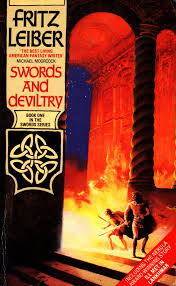I Read Books: Swords And Deviltry
Swords and Deviltry
The first volume in the seven volume series that collected Fafhrd and the Grey Mouser stories and came out in in my youth. (In fact the first 5 were published before I was born – Fritz Leiber published stories about the pair from 1939 until 1988, only a few years before his death in 1992). This is the first in internal chronology and is made up of four parts plus an introduction which boldly and boastfully describes them as
The first, Induction (1957, taken from a previous collection before these stories were written), basically tells us about the world and characters with full and lush descriptions. It tells us what we’re in for.
In The Snow Women, Fafhrd, a youth in his tribe at Cold Corner, has a fascination with civilization. This puts him at odds with most people there, including his mother and the other women (using cold magic against the men who are hosting a (rude) theatrical performance), his pregnant girlfriend Mara and her brothers, and the theatrical owners. After a certain amount of running, hiding, a spectacular rocket-propelled ski-jump and fighting, Fafhrd leaves with his first love Vlana, a thief and actress from the ancient and decadent city of Lankhmar (sorry Mara, who I am sure is completely forgotten) with a vendetta against the Thieves Guild.
In The Unholy Grail, Mouse, not yet The Grey Mouser, is apprentice to a white wizard, Glavas Rho. The other apprentice is Ivrian, the daughter of the wizard-hating Duke Janarrl. The Duke kills the wizard, Mouser turns evil and blames Ivrian. In the end he gets his revenge, is reconciled with Ivrian (his first love) and they flee to Lankhmar.
Finally in Ill-Met In Lankhmar (Hugo and Nebula award winner for Best Novella), Fafhrd and The Grey Mouser meet and join forces while robbing the Thieves Guild, Fafhrd as part of Vlana’s feud, Mouser to keep Ivrian in luxuries. Unfortunately the Thieves Guild have a sorcerer on staff and while they infiltrate the Guildhouse he takes a hideous revenge. They take their own vengeance in turn and then leave Lankhmar swearing never to return.
Read This: For an introduction to the classic low fantasy, swords and sorcery, rogues and thieves series, the pair always being put on the backfoot by events, not quite as clever as they think, having to improvise desperately and hilariously, yet with a touch of heart and emotion at the core.
Don’t Read This: The individual origin stories are inessential, Ill-Met In Lankhmar is genuinely good, but if you aren’t interested in rich, over-lush prose and weird dark magics mixed with daring robberies then this is not for you
The first volume in the seven volume series that collected Fafhrd and the Grey Mouser stories and came out in in my youth. (In fact the first 5 were published before I was born – Fritz Leiber published stories about the pair from 1939 until 1988, only a few years before his death in 1992). This is the first in internal chronology and is made up of four parts plus an introduction which boldly and boastfully describes them as
“...the greatest swordsmen ever to be in this or any other universe of fact or fiction, more skilful masters of the blade even than Cyrano de Bergerac, Scar Gordon, Conan, John Carter, D’Artagnan, Brandoch Daha and Anra Devadoris.”Although this sets the scene and tone, more interestingly Leiber credits the idea of the pair and their patron wizards to Harry Otto Fischer. Anyway, although these are the earliest adventures of Fafhrd and the Grey Mouser, they were mostly written in the 60s and 70s, the middle period of composition. But enough history of the stories, let’s see what’s in them.
The first, Induction (1957, taken from a previous collection before these stories were written), basically tells us about the world and characters with full and lush descriptions. It tells us what we’re in for.
In The Snow Women, Fafhrd, a youth in his tribe at Cold Corner, has a fascination with civilization. This puts him at odds with most people there, including his mother and the other women (using cold magic against the men who are hosting a (rude) theatrical performance), his pregnant girlfriend Mara and her brothers, and the theatrical owners. After a certain amount of running, hiding, a spectacular rocket-propelled ski-jump and fighting, Fafhrd leaves with his first love Vlana, a thief and actress from the ancient and decadent city of Lankhmar (sorry Mara, who I am sure is completely forgotten) with a vendetta against the Thieves Guild.
In The Unholy Grail, Mouse, not yet The Grey Mouser, is apprentice to a white wizard, Glavas Rho. The other apprentice is Ivrian, the daughter of the wizard-hating Duke Janarrl. The Duke kills the wizard, Mouser turns evil and blames Ivrian. In the end he gets his revenge, is reconciled with Ivrian (his first love) and they flee to Lankhmar.
Finally in Ill-Met In Lankhmar (Hugo and Nebula award winner for Best Novella), Fafhrd and The Grey Mouser meet and join forces while robbing the Thieves Guild, Fafhrd as part of Vlana’s feud, Mouser to keep Ivrian in luxuries. Unfortunately the Thieves Guild have a sorcerer on staff and while they infiltrate the Guildhouse he takes a hideous revenge. They take their own vengeance in turn and then leave Lankhmar swearing never to return.
Read This: For an introduction to the classic low fantasy, swords and sorcery, rogues and thieves series, the pair always being put on the backfoot by events, not quite as clever as they think, having to improvise desperately and hilariously, yet with a touch of heart and emotion at the core.
Don’t Read This: The individual origin stories are inessential, Ill-Met In Lankhmar is genuinely good, but if you aren’t interested in rich, over-lush prose and weird dark magics mixed with daring robberies then this is not for you


Comments